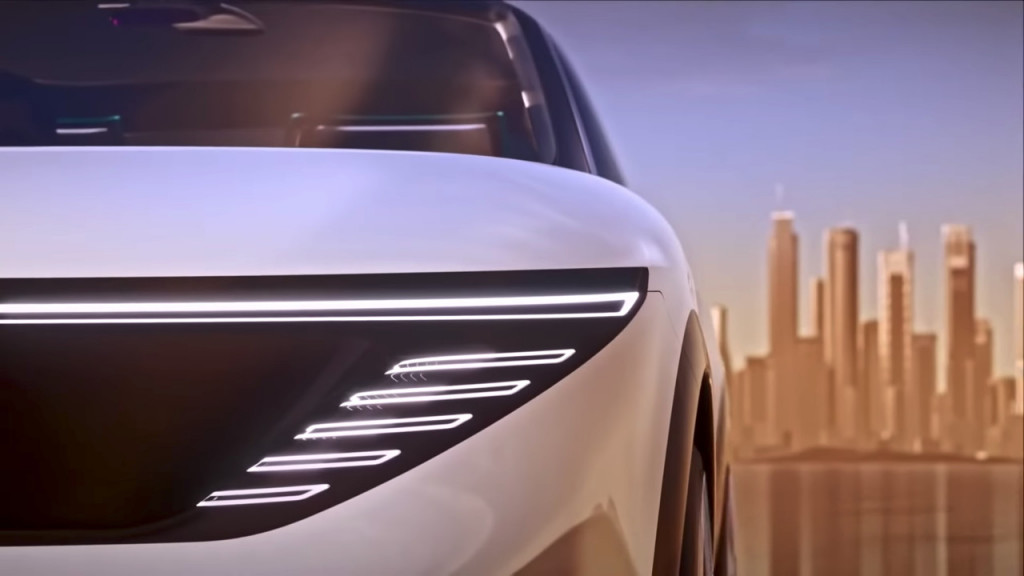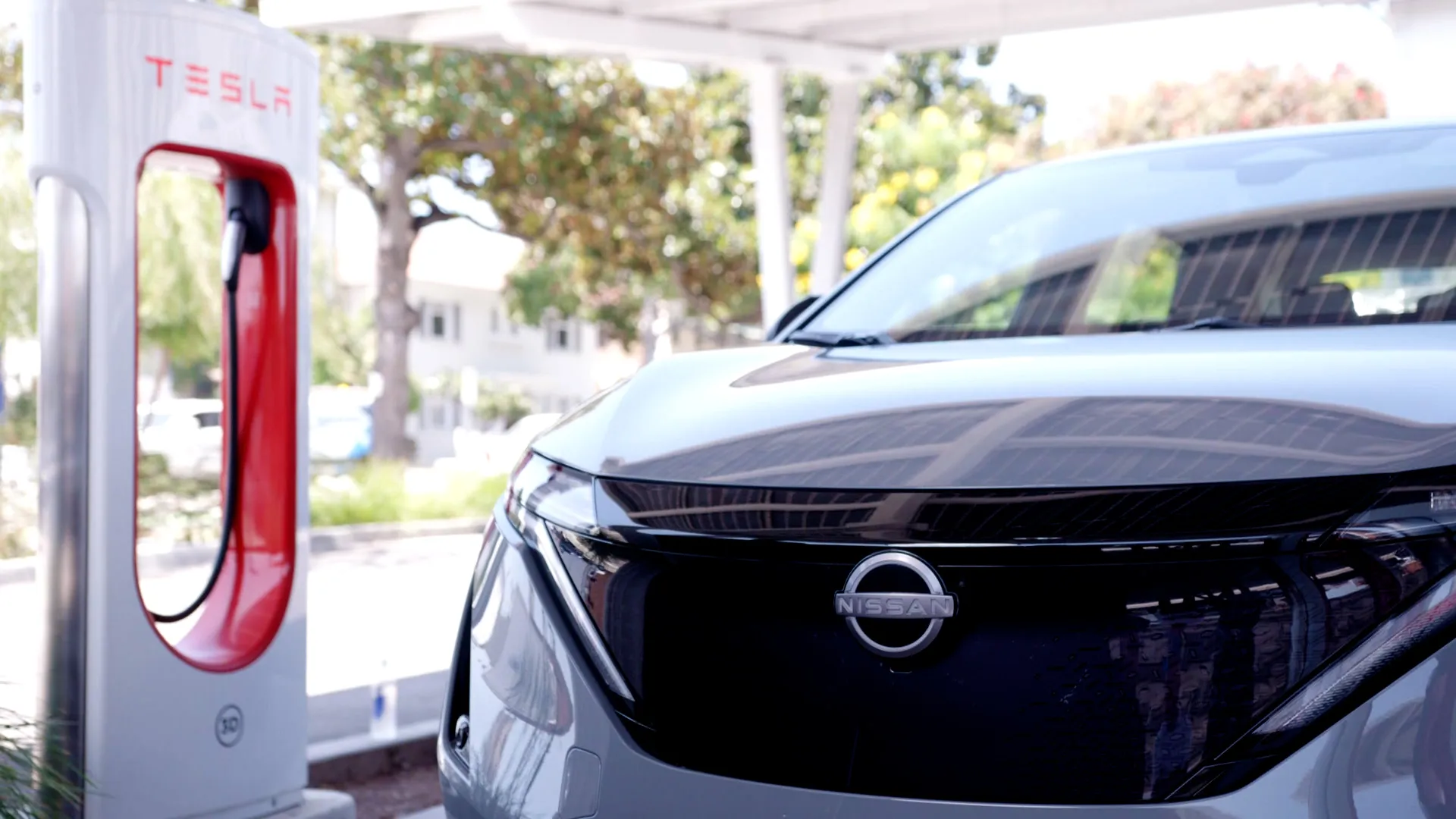- NACS will debut in Nissan-branded pure EV in 2025, be widely available in 2026
- Unclear whether that’s refreshed Ariya, or next-generation Leaf
- Nissan won’t immediately renew home charging around NACS
Nissan was the first Japanese automaker to confirm a switch to the Tesla-based North American Charging Standard (NACS) connector for future U.S.-market EVs.
It announced back in July 2023 that Nissan EVs with a NACS port would begin arriving in 2025, and in a recent check-in with Green Car Reports, Nissan confirmed that it remains on-track for that target—with a few more details.
Nissan is now offering a NACS adapter for the Ariya, which has a CCS charge port, so that it can take advantage of the Tesla Supercharger network and other additional NACS ports. That’s ahead of a message that Nissan is now adding a little more detail to: It confirmed Wednesday its plan to “introduce” a Nissan-branded pure EV with a native NACS port later this calendar year, and this model will be on sale in calendar-year 2026 if not sooner.
That potentially pegs a refreshed Ariya as the first U.S. Nissan with a NACS port. Nissan also has several Mississippi-made EVs in the works, but those have now been pushed out to 2028. A next-generation Nissan Leaf is likely to be previewed globally before the end of the year, but its U.S. arrival and timing are unclear as of yet.
Nissan Chill-Out concept – December 2021

Nissan Chill-Out concept – December 2021

Nissan Chill-Out concept – December 2021
In advance of this, Nissan updated its app earlier this year so that you can now see live station availability, compatibility with your vehicle, and what equipment is needed to achieve the peak charge rate. You can also start and stop charging sessions—even those on the Supercharger network—with the app.
To prepare for the adapters and then that bigger shift, Nissan already has all compatible Supercharger stations listed in the Nissan app, according to Ansu Jammeh, an engineer overseeing charging compatibility and development at Nissan in the U.S.
With NACS compatibility, Nissan added an additional 20,000 DC fast-charger posts, according to Jammeh, which essentially doubles the number of available connectors available to a Nissan customer.
Regardless of what happens with a range of factors such as the federal charging buildout, Nissan is expecting “steady growth” in U.S. charging infrastructure over the next few years, according to Jammeh. “Industry-wide, we still see the customer want, and the necessity, behind more charging infrastructure,” he underscored.
Home charging remains a big part of it, too, and Jammeh emphasized that part of it won’t be changing immediately—and it doesn’t need to, with adapters playing their part.
“The beautiful part is that, between J1772, CCS1, and NACS, they’re compatible,” said Jammeh. “So in terms of a customer, do they actually need to change their home infrastructure? No, they can utilize the same equipment they have.”
As for that adapter, it’s available now, and it can be purchased for $235 through Nissan dealers or directly from Nissan.
Nissan strongly advises against using a third-party adapter—or for that matter, even the Tesla Magix Dock, and cautions that it’s prohibited under Nissan’s own terms and may also violate Tesla’s terms of use for the Supercharger Network. In Nissan’s design specifically, a plastic tab that fits within the adapter helps it fit securely.
“If you’re going to access the NACS network, please do it with the approved Nissan NACS adapter kit,” he emphasized.
The adapter fully supports the Ariya’s peak charge rate of 130 kw, which allows it to charge from 10-80% in as little as 35 minutes, according to Nissan.

2023 Nissan Ariya at EVgo charging station
Jammeh said that looking ahead, Nissan “will support any change that needs to be done on the vehicle design or equipment side to make sure customers are best-equipped.” But the engineer couldn’t yet say whether or not that means better support in its electric vehicle products for bidirectional charging—just that it hopes to adopt those technologies in the future.
Future charging technology announcements, Jammeh hinted, might also correspond with Nissan’s plans to offer an all-solid-state battery in at least one global vehicle by 2028.
Nissan, on a global basis, has emphasized the importance of bidirectional charging tech, including vehicle-to-home (V2H) and vehicle-to-grid (V2G) technologies, and it once said those capabilities were built into the Ariya. CHECK. In the U.S., Nissan does support Leaf bidirectional charging, but the only compatible (and warranty-supported) unit at present is one that enables V2G rather than home-backup capability.
The Leaf is Nissan’s only U.S. vehicle to use the CHAdeMO charge port. A 2026 Nissan Rogue plug-in hybrid has also been confirmed, and seeing that its Mitsubishi Outlander PHEV cousin uses the CHAdeMO charge port, it will be interesting to see whether it arrives with that, CCS, or NACS.
In the meantime, with upcoming EVs, adapters, and different charge ports, it’s going to get exciting and be much more of a challenge for automakers to communicate what to plug into—both within apps and in-person.
Read the full article here



